A Strategic Guide to Crafting a Bird-Friendly Haven
Unlock the Secrets to Attracting and Nurturing Backyard Birds Year-Round with These Simple Strategies
October 2024
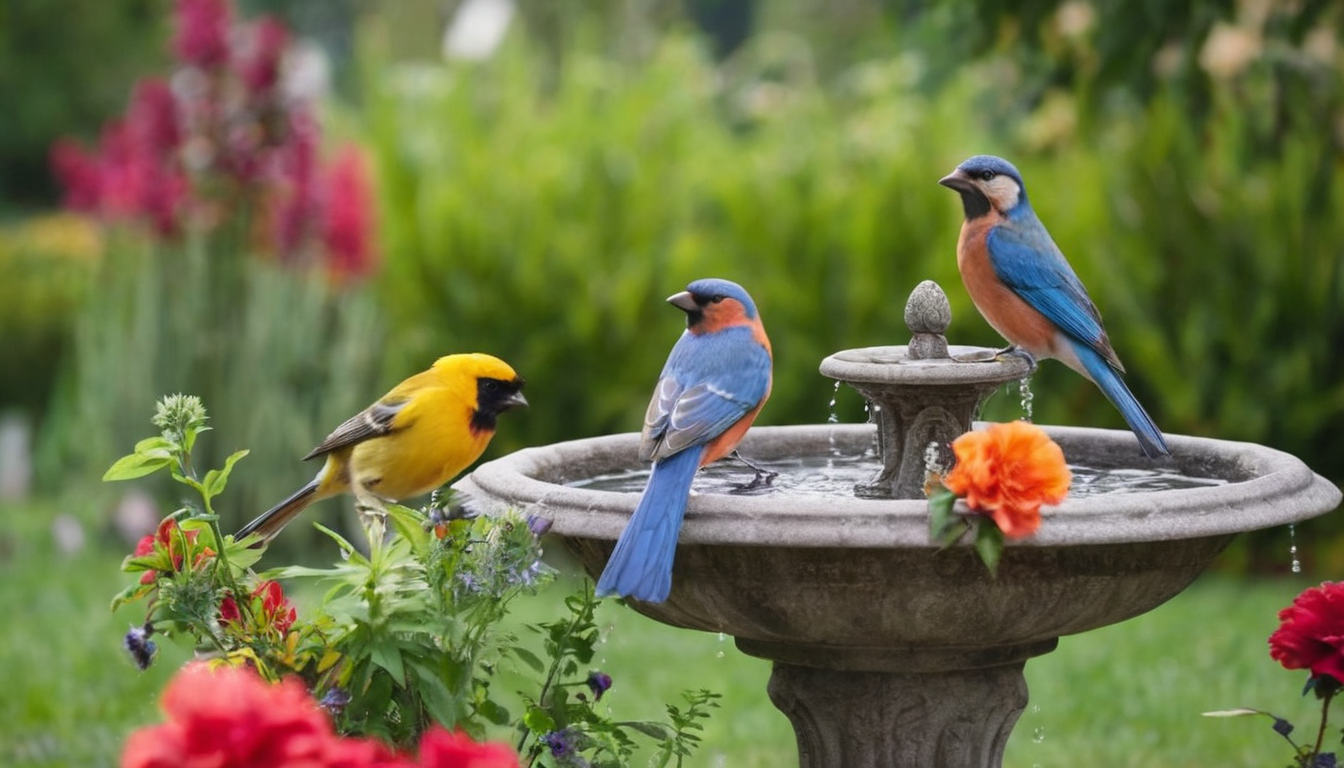
Illustration conveying 'A Bird-Friendly Haven'
Introduction
Are you captivated by the melodies and vibrant plumage of birds in your yard? Eager to contribute to their well-being amidst environmental challenges? Whether you have a sprawling garden or a cozy balcony, this guide navigates crafting a bird-friendly haven with expert-backed insights.
Birds, essential pollinators and pest controllers, face threats like habitat loss and climate shifts. Your bird-friendly garden isn't just visually appealing; it's a lifeline, contributing to their survival while offering you a front-row seat to nature's vibrant theater.
The Four Pillars of a Bird-Friendly Garden
Food, water, shelter, and perches are the cornerstones of a thriving bird haven. From seasonal insect banquets to accessible water sources, cozy shelters, and strategic perches, this guide provides actionable advice to turn your space into an avian oasis.
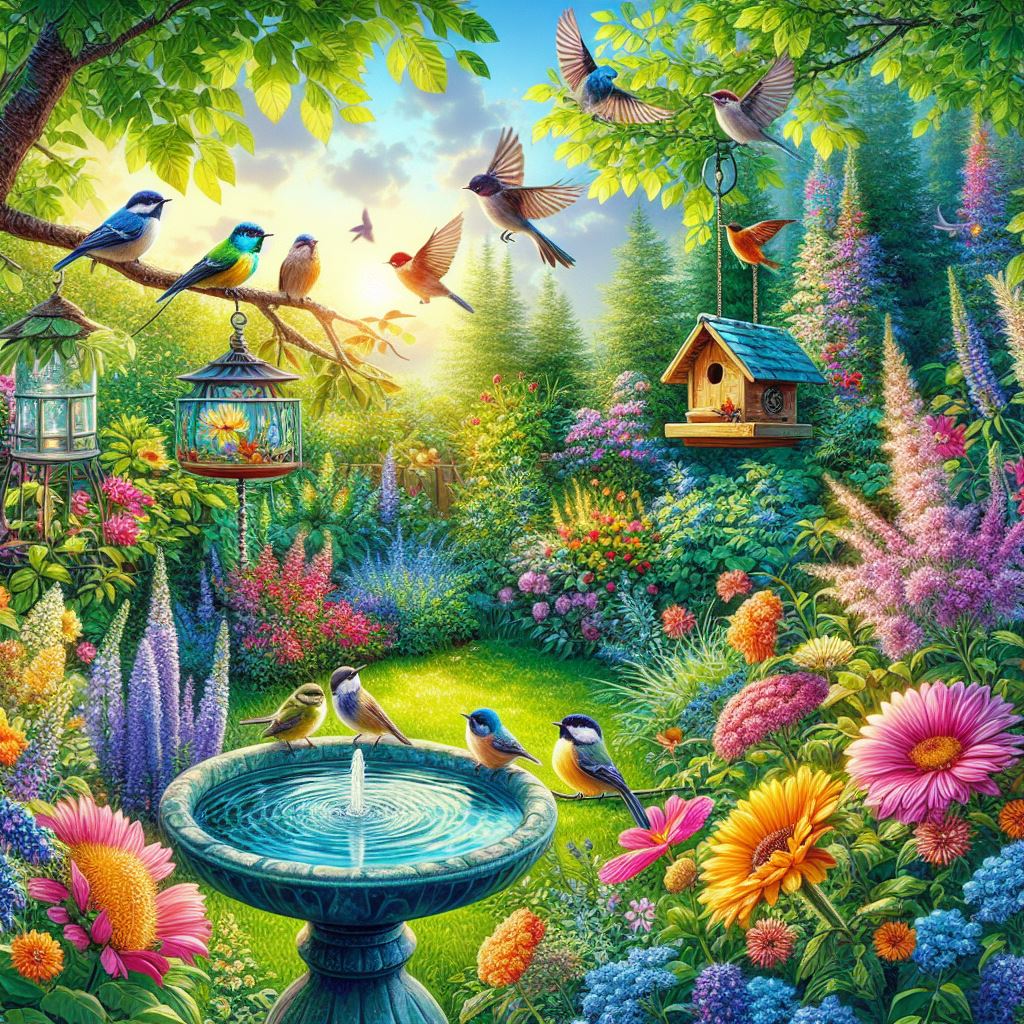
Illustration conveying 'The Four Pillars of a Bird-Friendly Garden'
Section 1: Sustaining Birdlife with Varied Nourishment
Exploring the role of diverse food sources throughout the seasons.
A bird-friendly garden necessitates a thoughtful approach to nourishment across the changing seasons. The provision of varied food sources aligns with birds' distinct needs during different times of the year.
Seasonal Considerations for Food Sources
A thriving bird-friendly garden adapts to the changing seasons, ensuring a reliable pantry for its feathered clientele. Here's an overview of the distinct dietary requirements of our feathered visitors throughout the year:
Spring
-
Insect Feast: Caterpillars are the protein-packed prize for growing chicks. Attract a buffet of insect life by planting native species like milkweed, coneflowers, and blueberry bushes.
-
Nectar Nosh: Hummingbirds and other early migrants crave the sweet nectar of early bloomers like columbine, penstemon, and red honeysuckle.
-
Seed Snacks: Sunflower seeds in feeders provide a nutritious boost as birds establish territories and rebuild energy after migration.
Summer
-
Berries Bonanza: Native berry bushes like blueberries, raspberries, and elderberries offer a refreshing and vitamin-rich treat for growing chicks and molting adults.
-
Fat & Protein Power: Suet cakes and mealworms in feeders offer a concentrated source of these crucial nutrients, especially helpful for raising young and preparing for fall migration.
-
Fruits & Jelly Delights: Unflavored jelly and ripe fruits like oranges and grapes can supplement natural food sources in moderation. Just place feeders strategically to avoid overheating and attracting wasps.
Fall
-
Fuel for the Flight: Stock up on high-calorie fare like sunflower seeds, cracked corn, and nuts like acorns and hickory nuts to help birds build fat reserves for their long journeys south.
-
Seed Symphony: Native plants like asters, coneflowers, and goldenrod produce a bounty of tiny seeds perfect for finches and sparrows.
-
Winter Wonderland Buffet: Leaving fallen leaves, twigs, and brush piles provides natural foraging grounds for insects and seeds, offering a late-season feast for resident birds.
Winter
-
High-Fat Havens: Suet cakes, peanut butter feeders, and black oil sunflower seeds become crucial winter staples, giving birds the energy to battle the cold.
-
Evergreen Bounty: Trees and shrubs like pines, firs, hollies, and junipers offer both shelter and a smorgasbord of berries and seeds throughout the winter months.
By thoughtfully adjusting your garden's food offerings with the seasons, you can transform it into a year-round sanctuary for birds of all appetites. Remember, even small changes, like planting a native berry bush or hanging a suet feeder, can make a world of difference in supporting your feathered friends throughout the year.

Illustration conveying 'Seasonal Considerations for Food Sources'
Seasonal Food Source Table
| Season | Food Source | Birds Attracted | Notes |
|---|---|---|---|
| Spring | Insect Feast: Caterpillars, grubs, spiders | Songbirds, chickadees, warblers | Plant native flowers and shrubs like milkweed, coneflowers, and blueberry bushes to attract insect life. |
| Nectar Nosh: Columbine, penstemon, red honeysuckle | Hummingbirds, early migrants | Provide hummingbird feeders with sugar water or plant early blooming flowers for their sweet nectar. | |
| Seed Snacks: Sunflower seeds, birdseed mixes | Finches, sparrows, cardinals | Use feeders or scatter birdseed mixes on the ground for a nutritious boost. | |
| Summer | Berries Bonanza: Blueberries, raspberries, elderberries | Thrushes, robins, finches | Provide native berry bushes for a refreshing and vitamin-rich treat for birds. |
| Fat & Protein Power: Suet cakes, mealworms | Woodpeckers, chickadees, wrens | Offer suet cakes and mealworms in feeders for a concentrated source of protein, especially helpful for raising young. | |
| Fruits & Jelly Delights: Unflavored jelly, oranges, grapes | Robins, blue jays, mockingbirds | Offer fruits and unflavored jelly in moderation and place feeders strategically to avoid overheating and attracting wasps. | |
| Fall | Fuel for the Flight: Sunflower seeds, cracked corn, nuts | Cardinals, jays, grosbeaks | Provide high-calorie foods like sunflower seeds, cracked corn, and nuts to help birds build fat reserves for migration. |
| Seed Symphony: Asters, coneflowers, goldenrod | Finches, sparrows, juncos | Plant native fall-blooming flowers like asters, coneflowers, and goldenrod for a late-season seed feast. | |
| Winter Wonderland Buffet: Fallen leaves, twigs, brush piles | Chickadees, nuthatches, creepers | Leave fallen leaves, twigs, and brush piles undisturbed to provide natural foraging grounds for insects and seeds. | |
| Winter | High-Fat Havens: Suet cakes, peanut butter feeders, black oil sunflower seeds | Woodpeckers, chickadees, titmice | Offer high-fat foods like suet cakes, peanut butter feeders, and black oil sunflower seeds to help birds conserve energy during cold weather. |
| Evergreen Bounty: Pines, firs, hollies, junipers | Cardinals, finches, waxwings | Plant evergreens with berries and seeds to offer food and shelter throughout winter. |
The Role of Native Plants
The strategic planting of native species emerges as a key practice in providing diverse food sources for birds. Native plants, adapted to specific regions, offer numerous advantages:
-
They are more attractive to insects, ensuring a steady food supply for birds.
-
They produce berries or seeds that birds can consume or store for later.
-
They contribute to environmental well-being by conserving water, preventing soil erosion, and supporting biodiversity.
Selecting Native Plants for Different Regions
Depending on your geographic region, choosing suitable native plants becomes crucial. Here are examples tailored for various regions in the United States:
-
Northeast: Serviceberry (Amelanchier spp.), Dogwood (Cornus spp.), Spicebush (Lindera benzoin), and Sunflower (Helianthus spp.).
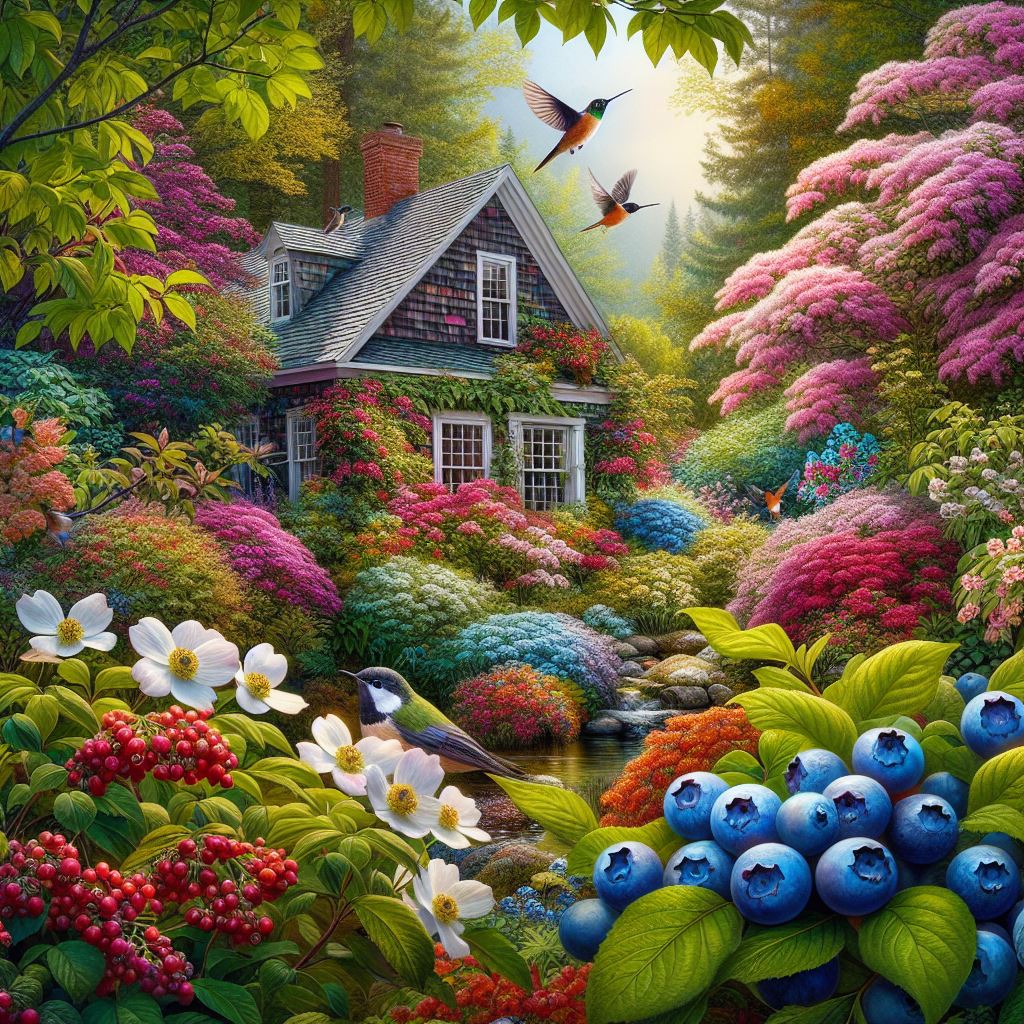
Illustration conveying 'Northeast Native Plants'
-
Southeast: Redbud (Cercis canadensis), Beautyberry (Callicarpa americana), Pawpaw (Asimina triloba), and Coneflower (Echinacea spp.).
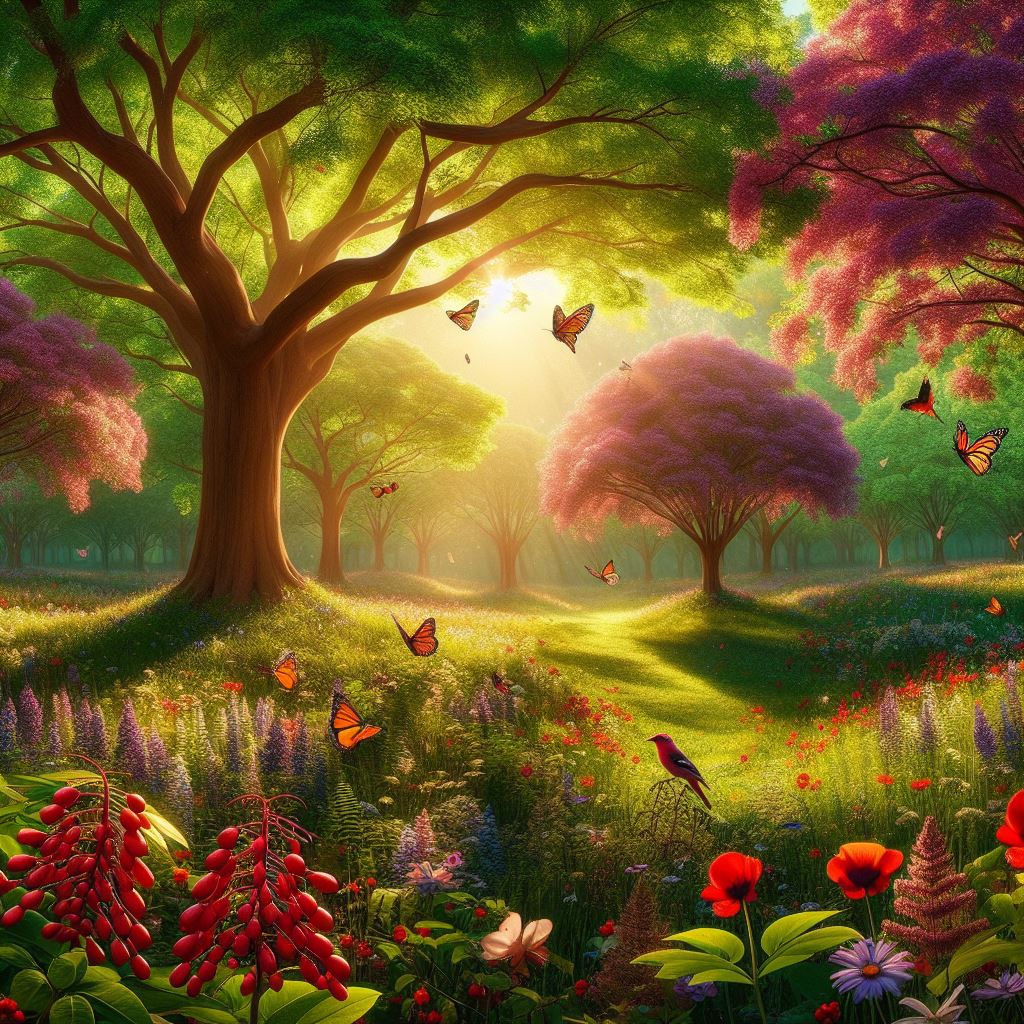
Illustration conveying 'Southeast Native Plants'
-
Midwest: Crabapple (Malus spp.), Elderberry (Sambucus spp.), Milkweed (Asclepias spp.), and Blazing Star (Liatris spp.).
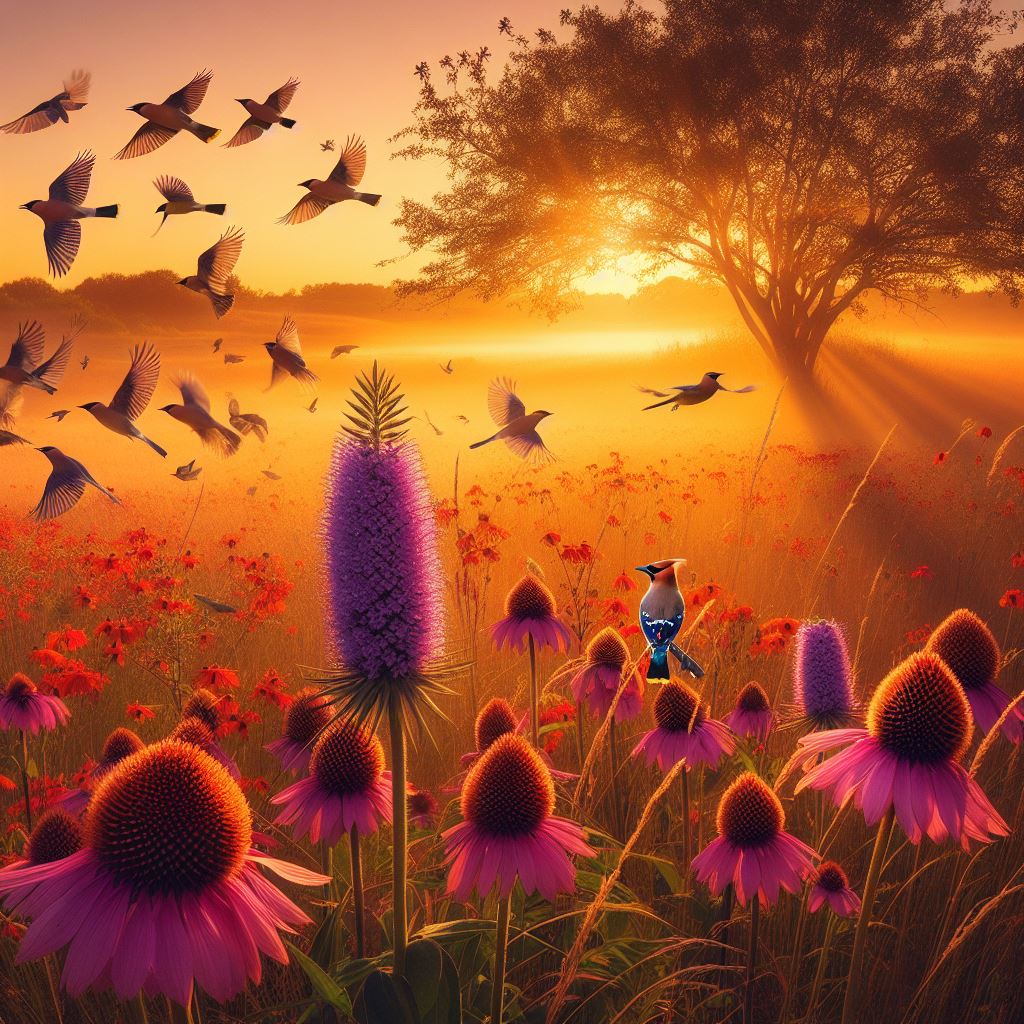
Illustration conveying 'Midwest Native Plants'
-
Southwest: Mesquite (Prosopis spp.), Cholla (Cylindropuntia spp.), Penstemon (Penstemon spp.), 'Don's Dwarf' Wax Myrtle (Myrica cerifera spp.), and Sagebrush (Artemisia spp.).

Illustration conveying 'Southwest Native Plants'
-
Northwest: Pacific Madrone (Arbutus menziesii), Oregon Grape (Mahonia spp.), Huckleberry (Vaccinium spp.), American Beautyberry (Callicarpa spp.), and Lupine (Lupinus spp.).
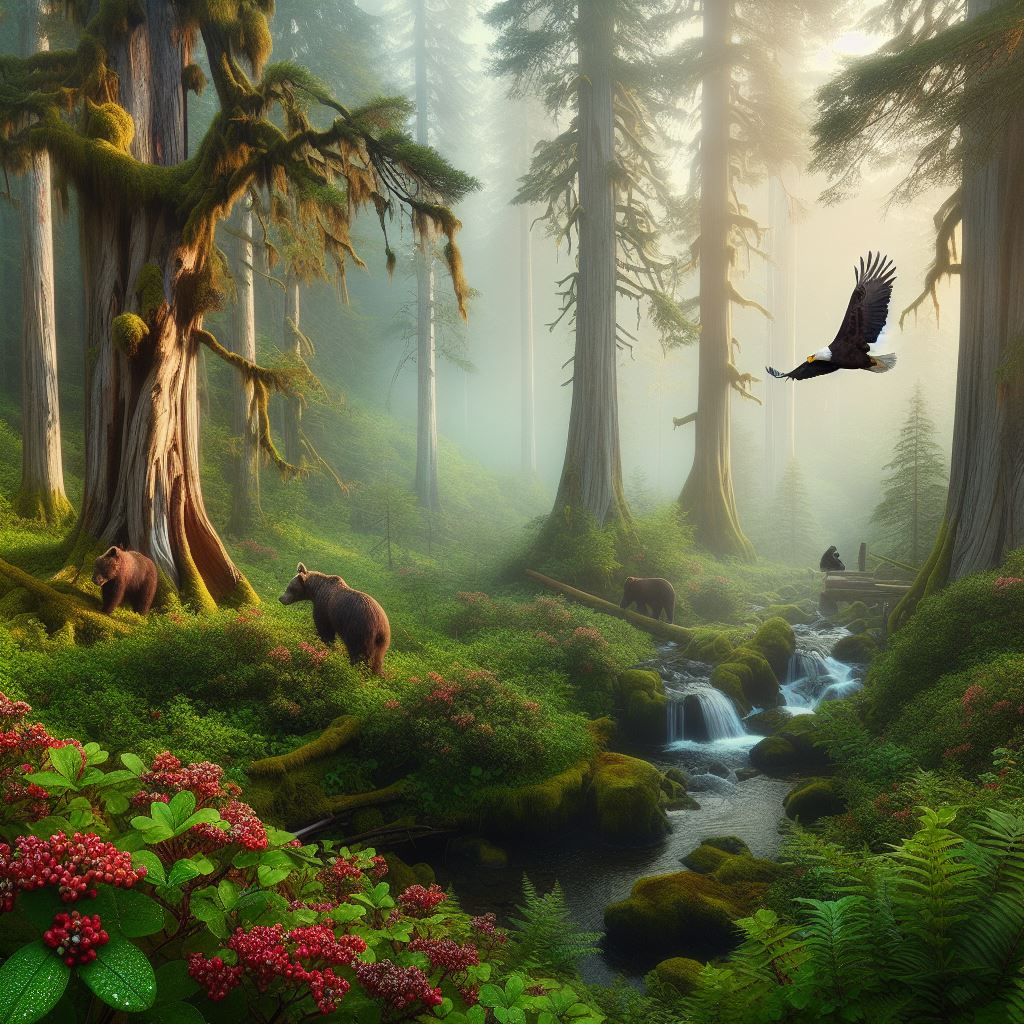
Illustration conveying 'Northwest Native Plants'
Optimizing Different Yard Sizes
To create a bird-friendly garden, your yard size plays a significant role in planning and execution. Tailoring your approach based on the available space is essential:
-
Small yards: For small yards, you can use containers to grow native plants that attract and support birds.
Here are some tips for container gardening:
-
Use containers at least 12 inches wide and deep to provide ample room for plant roots.
-
Select plants with different heights and textures for visual interest, such as grasses, ferns, and flowers.
-
Place containers near water sources, such as birdbaths or saucers, to attract and hydrate birds.
-
Add some rocks or pebbles to the water sources to provide perches and prevent drowning.
-
Change the water regularly to keep it fresh and clean.
-
-
Medium yards: For medium yards, you can plant shrubs or trees to create a bird-friendly garden.
Here are some tips for planting shrubs or trees:
-
Plant them in groups of three or five to create focal points and provide shelter and nesting sites for birds.
-
Choose species with colorful foliage or berries to add contrast and texture, such as dogwoods, viburnums, and hollies.
-
Avoid planting too close to fences or walls to prevent root damage and allow air circulation.
-
Provide water sources, such as ponds or fountains, to entice and support birdlife.
-
Add some aquatic plants, such as water lilies or duckweed, to provide cover and food for birds.
-
-
Large yards: For large yards, you can plant trees to create a bird-friendly garden.
Here are some tips for planting trees:
-
Plant them at least 10 feet apart for optimal growth without crowding and to create a canopy layer for birds.
-
Select species with different bloom times for year-round interest, such as maples, oaks, and cherries.
-
Provide water sources, such as streams or waterfalls, to enhance and sustain birdlife.
-
Add some rocks, logs, or branches to the water sources to provide perches and hiding places for birds.
-
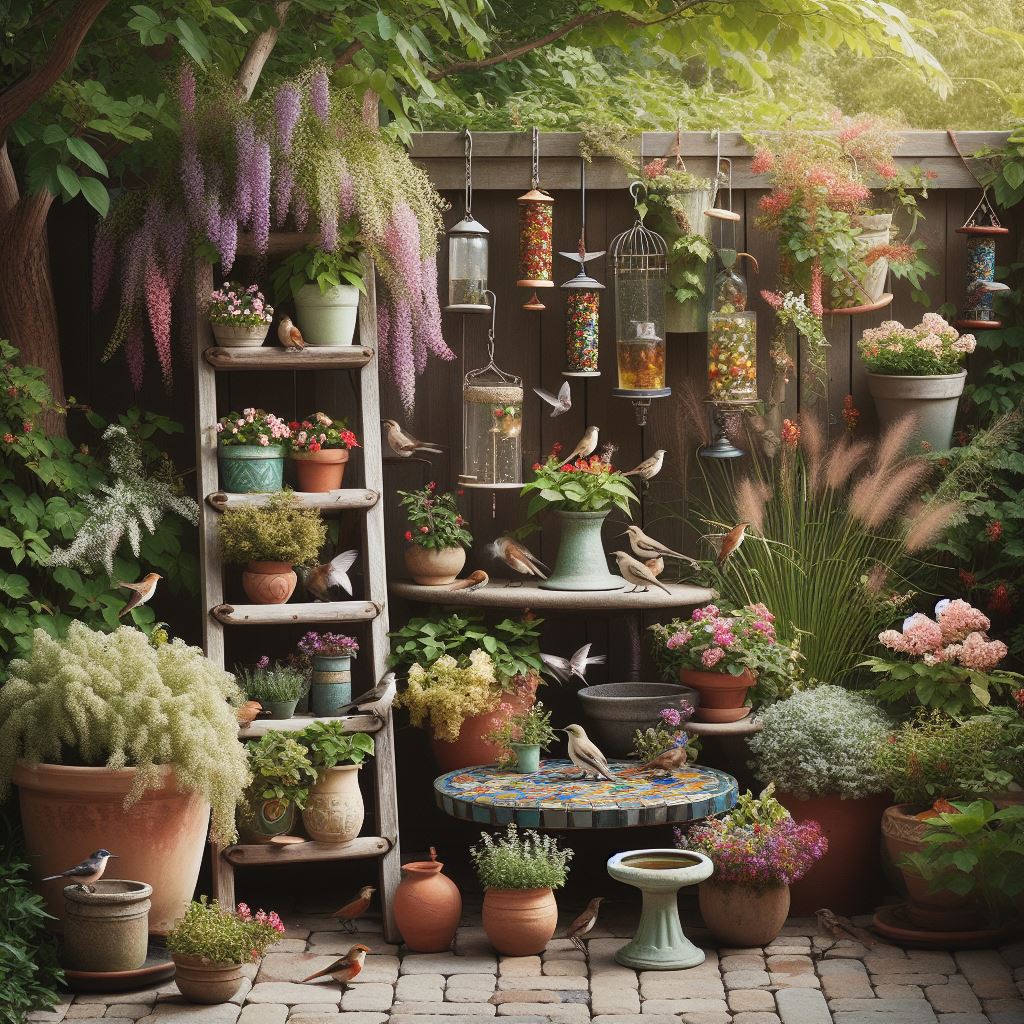
Illustration conveying 'Optimizing for Small Yards'
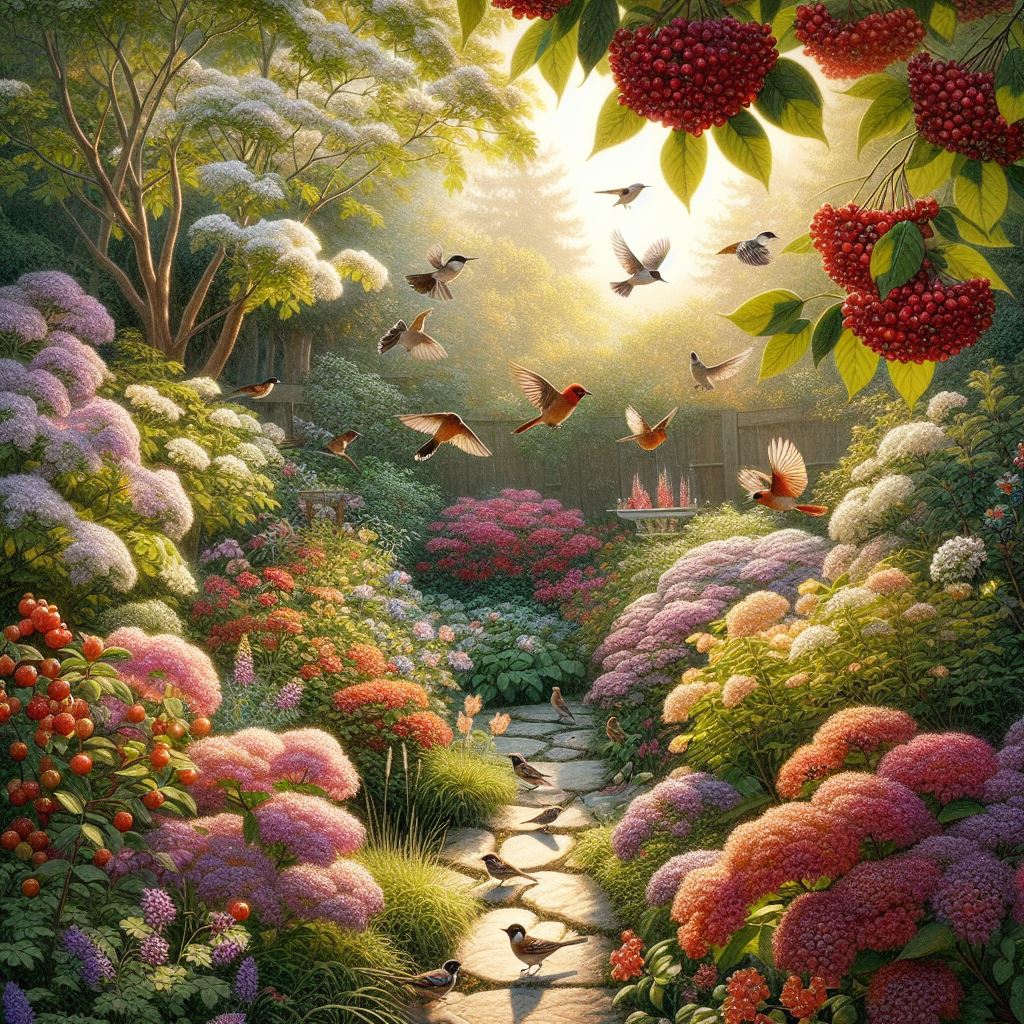
Illustration conveying 'Optimizing for Medium Yards'
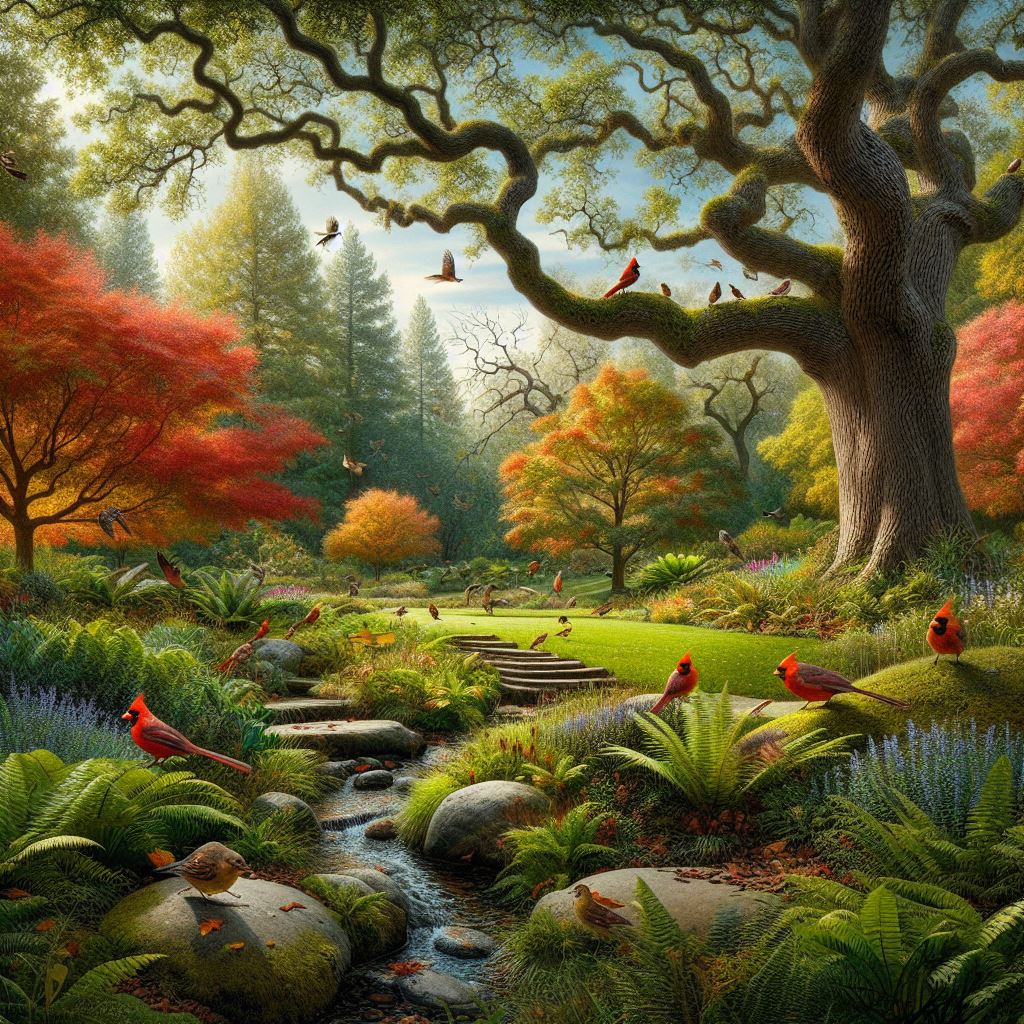
Illustration conveying 'Optimizing for Large Yards'
Introduction to Feeders
An additional method of providing food for birds in your garden is through feeders. These come in various types, each catering to specific foods and bird types. However, maintaining feeder hygiene is crucial to prevent diseases and pests. Some examples of feeders include:
-
Tube feeders: Cylindrical containers with holes and perches for seeds, such as sunflower, safflower, or millet. They are suitable for small to medium-sized birds, such as finches, chickadees, or titmice.
-
Hopper feeders: Box-shaped containers with openings and trays for seeds, such as sunflower, corn, or mixed. They are suitable for medium to large-sized birds, such as cardinals, jays, or grosbeaks.
-
Suet feeders: Wire cages or mesh bags that hold suet, which is animal fat mixed with seeds, nuts, or fruits. They are suitable for insect-eating birds, such as woodpeckers, nuthatches, or wrens.
-
Nectar feeders: Plastic or glass containers with tubes or ports for nectar, which is sugar water mixed with food coloring. They are suitable for hummingbirds, orioles, or tanagers.
When installing these feeders, you need to ensure the quality and quantity of the food and the safety and hygiene of the birds. Here are some tips for different feeders:
-
For tube feeders: Use metal or plastic materials that are durable and easy to clean. Hang them from poles or branches at least five feet above the ground. Clean them weekly with hot water and vinegar to prevent mold and bacteria. Refill them as needed with fresh seeds.
-
For hopper feeders: Use wood or metal materials that are sturdy and weather-resistant. Mount them on poles or posts at least five feet above the ground. Clean them monthly with hot water and soap to prevent rot and insects. Refill them as needed with fresh seeds.
-
For suet feeders: Use wire or mesh materials that are strong and breathable. Hang them from poles or branches at least five feet above the ground. Replace them every two weeks or when they become rancid or empty. Refill them with fresh suet.
-
For nectar feeders: Use plastic or glass materials that are transparent and leak-proof. Hang them from poles or branches at least five feet above the ground. Change the nectar every three days or when it becomes cloudy or fermented. Refill them with fresh nectar.
By incorporating feeders into your bird-friendly garden, you offer an additional food source while enjoying the delightful presence of birds. Maintaining these feeders involves regular cleaning and refilling to ensure the well-being of both birds and the ecosystem.
Creating a bird-friendly garden is a rewarding and beneficial endeavor. You can enjoy the beauty and diversity of birdlife in your garden, while also supporting the ecosystem and the environment. By providing diverse and native food sources, you are not only helping birds survive and thrive; you are also protecting biodiversity and promoting sustainability.
Section 2: Quenching Thirst and Bathing Beauties
Essential insights into providing water for hydration, bathing, and habitat enrichment.
Providing birds with water is fundamental for cultivating a bird-friendly environment. It supports critical activities like drinking, bathing, and cooling off, vital due to their higher metabolic rate and body temperature. Incorporating clean, accessible water sources in your garden not only attracts diverse bird species but also contributes significantly to the well-being of local wildlife.
Water features stand out as effective means to creating a bird-friendly space. However, before introducing a water feature to your garden, thoughtful consideration of your budget, style, and space availability is imperative. Different water features come with varying costs, sizes, and designs, catering to diverse preferences and garden layouts.
Here are some examples of water features that offer hydration and bathing opportunities for birds:
-
Birdbaths (also known as bird pools or bird basins): Shallow basins for drinking and bathing, placed on the ground, pedestal, or hung from a branch. They are easy to install and clean, but they may need frequent refilling and protection from predators and parasites.
-
Fountains (also known as water jets or water spouts): Devices that pump water into the air or through a nozzle, creating sound and movement that attract birds and insects. They are attractive and recirculate water, but they may need plumbing, electricity, and winterization to prevent damage.
-
Ponds (also known as pools or lakes): Bodies of water, natural or artificial, large or small, deep or shallow, providing habitat for aquatic plants and animals. They are diverse and natural, but they may need filtration, aeration, and landscaping to maintain clean and healthy water.
Creating and maintaining these features involves careful consideration of your budget, the complexity of maintenance, and ensuring the safety and hygiene of the water for both birds and humans.
Here are some tips for maintaining different water features:
-
For birdbaths: Place them in a shady spot near cover for bird safety and cool water. Adding stones or pebbles provides grip for birds. Regular cleaning and refilling prevent algae and bacteria growth. Adding a dripper or a mister can create movement and sound to attract more birds.
-
For fountains: Choose designs that recirculate water to avoid wastage. Add chlorine or vinegar to prevent algae growth. Regular maintenance and winterization prevent damage. Avoid metal or plastic materials that can heat up or leach chemicals into the water.
-
For ponds: Dig at least 18 inches deep to prevent complete freezing in winter. Introduce plants like water lilies or cattails for oxygen and shade. Filtration and aeration maintain clean and healthy water. Add rocks, logs, or branches to provide perches and hiding places for birds.
Introducing these water features can draw a diverse array of bird species. Yet, supplying water for birds is not always a straightforward task. It requires thoughtful consideration of the most effective methods to establish and upkeep water sources, whether through birdbaths, fountains, or ponds.
By understanding the significance of water for birds and learning effective ways to provide it, we not only create a more hospitable environment for our avian friends but also contribute to a richer, more sustainable ecosystem in our immediate surroundings.
Section 3: Safe Havens - Shelter and Sanctuary
Understanding the significance of thick foliage, trees, and birdhouses as protective havens.
Shelter, the third crucial component of a bird-friendly garden, provides birds protection from predators, weather, and human interference. It also offers spaces for birds to rest, roost, and raise their young. Inadequate shelter can lead to increased stress, disease, and mortality in birds. Thus, creating shelter in your garden is not only beneficial for birds but also for the health and balance of your ecosystem.
Native Plants for Shelter
One of the best ways to create shelter for birds is by planting native shrubs and trees with thick, dense, or thorny foliage. Native plants, evolved for specific regions, adapt to local climates and soils while supporting native insects and other food sources for birds. Examples of native plants for different regions in the United States include:
-
Northeast: Holly (Ilex spp.) with glossy, spiny leaves and bright red berries providing year-round cover and food for cardinals, robins, bluebirds, and cedar waxwings.
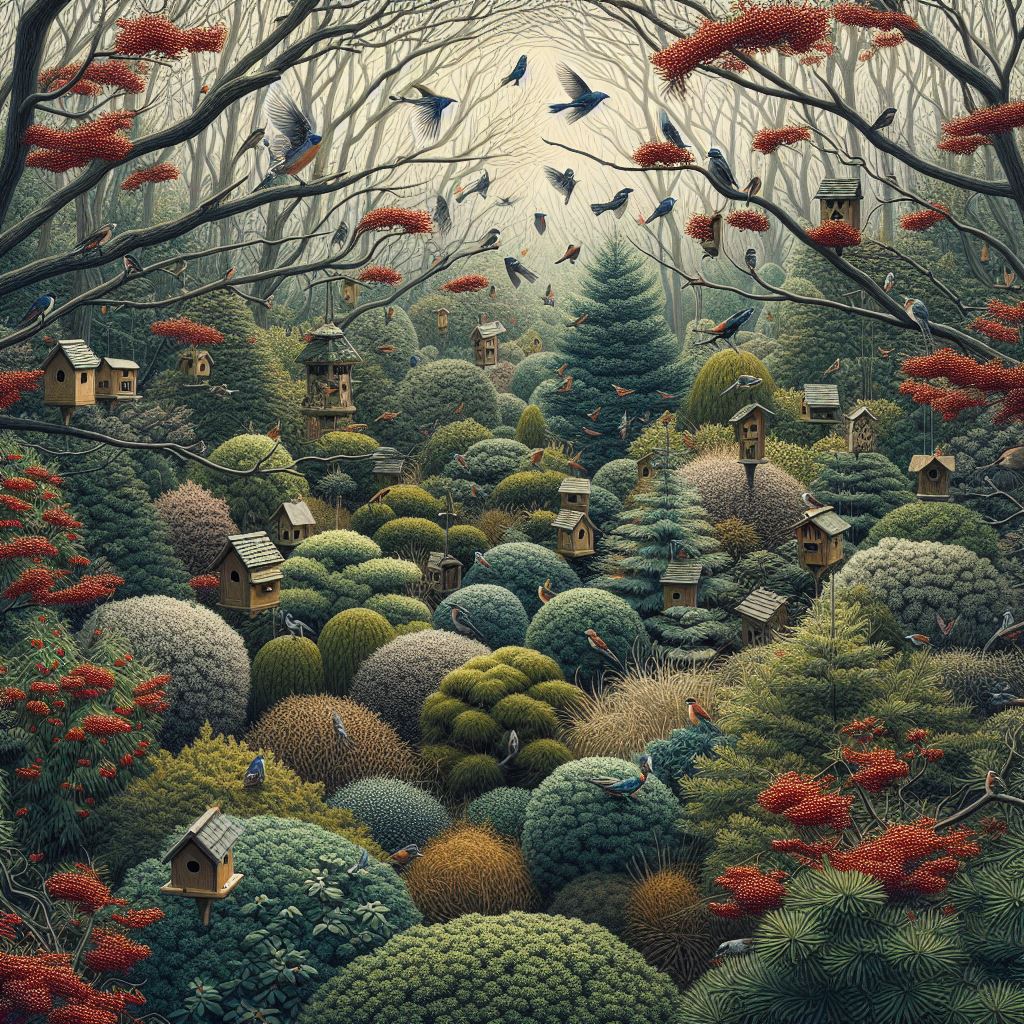
Illustration conveying 'Native Plants for Shelter in the Northeast US'
-
Southeast: Redbud (Cercis canadensis) with heart-shaped leaves and pink or purple flowers providing seasonal cover and food for hummingbirds, orioles, and tanagers.
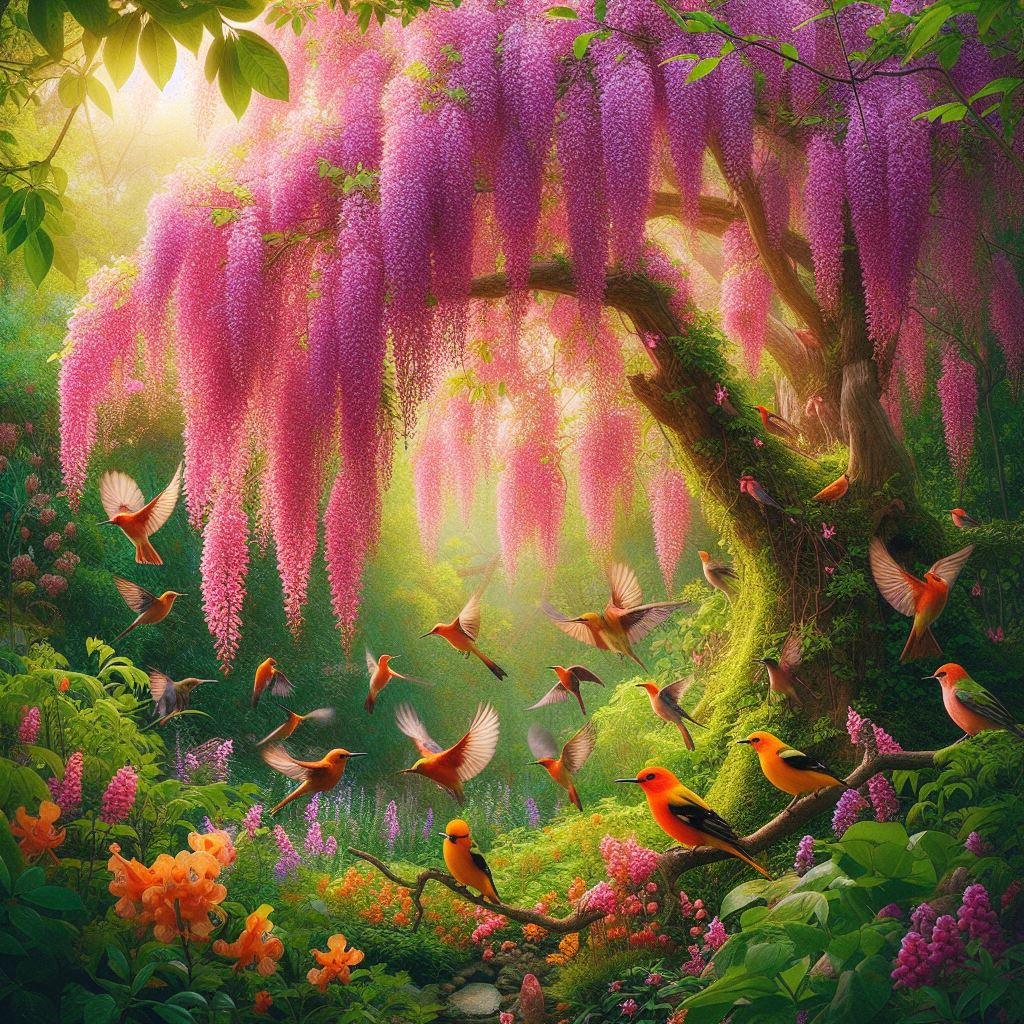
Illustration conveying 'Native Plants for Shelter in the Southeast US'
-
Midwest: Crabapple (Malus spp.) with serrated leaves and colorful fruits providing seasonal cover and food for waxwings, thrushes, and grosbeaks.
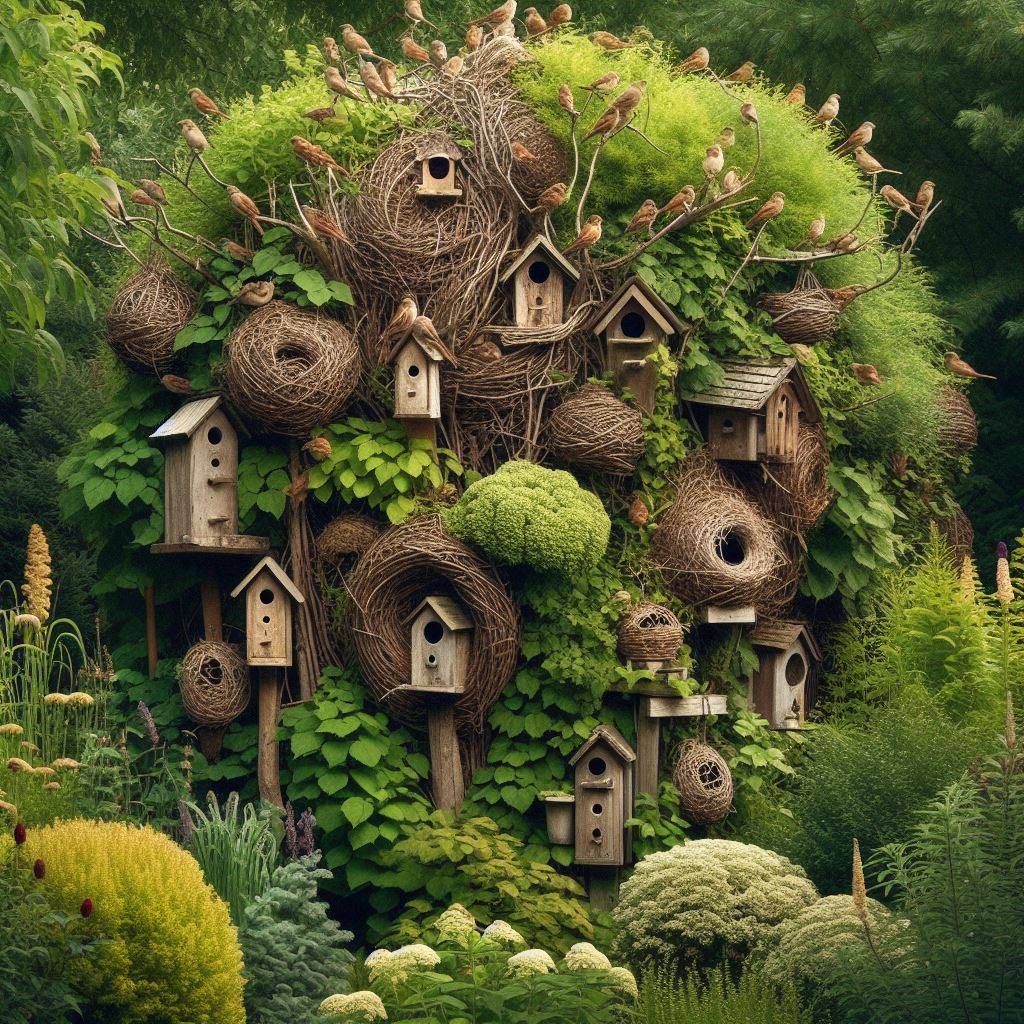
Illustration conveying 'Native Plants for Shelter in the Midwest US'
-
Southwest: Mesquite (Prosopis spp.) with feathery leaves and yellow flowers providing year-round cover and food for quail, doves, and sparrows.
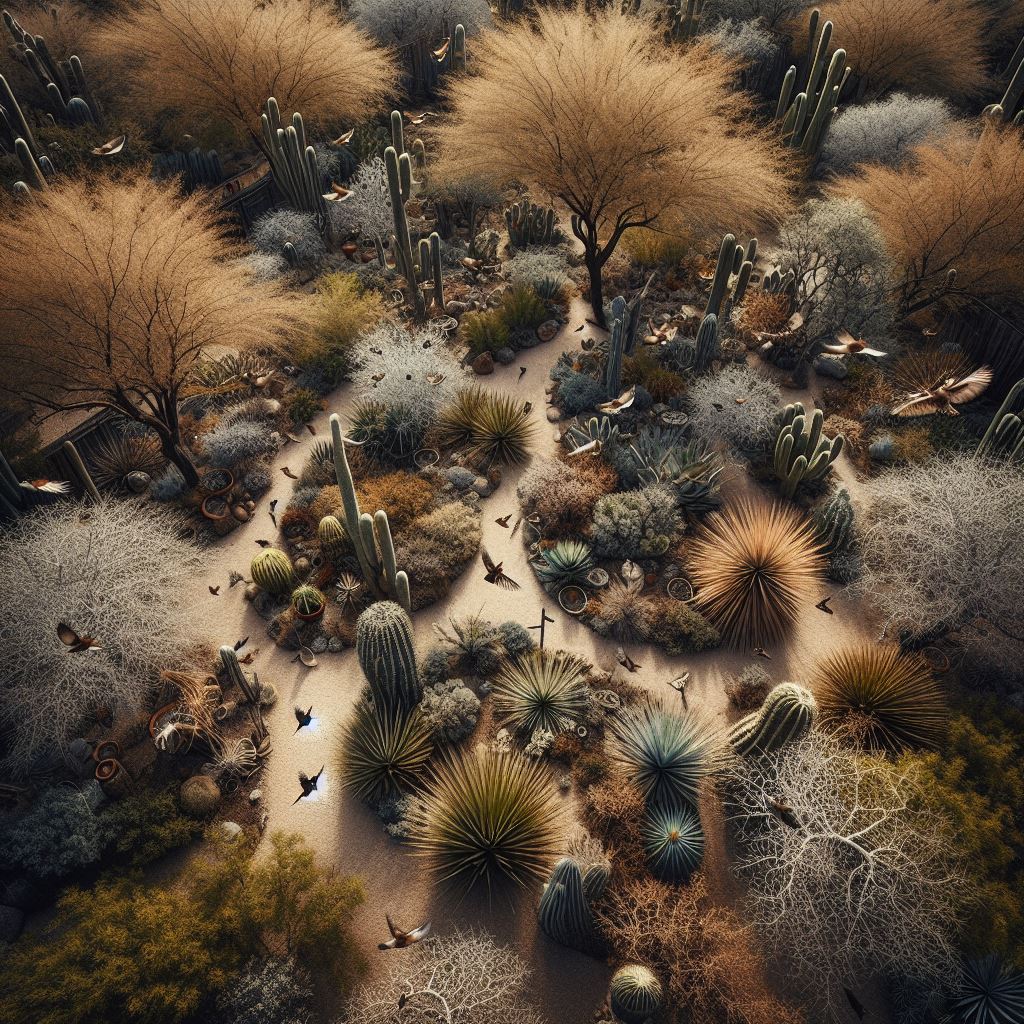
Illustration conveying 'Native Plants for Shelter in the Southwest US'
-
Northwest: Pacific Madrone (Arbutus menziesii) with leathery leaves and red-orange berries providing year-round cover and food for jays, robins, and towhees.
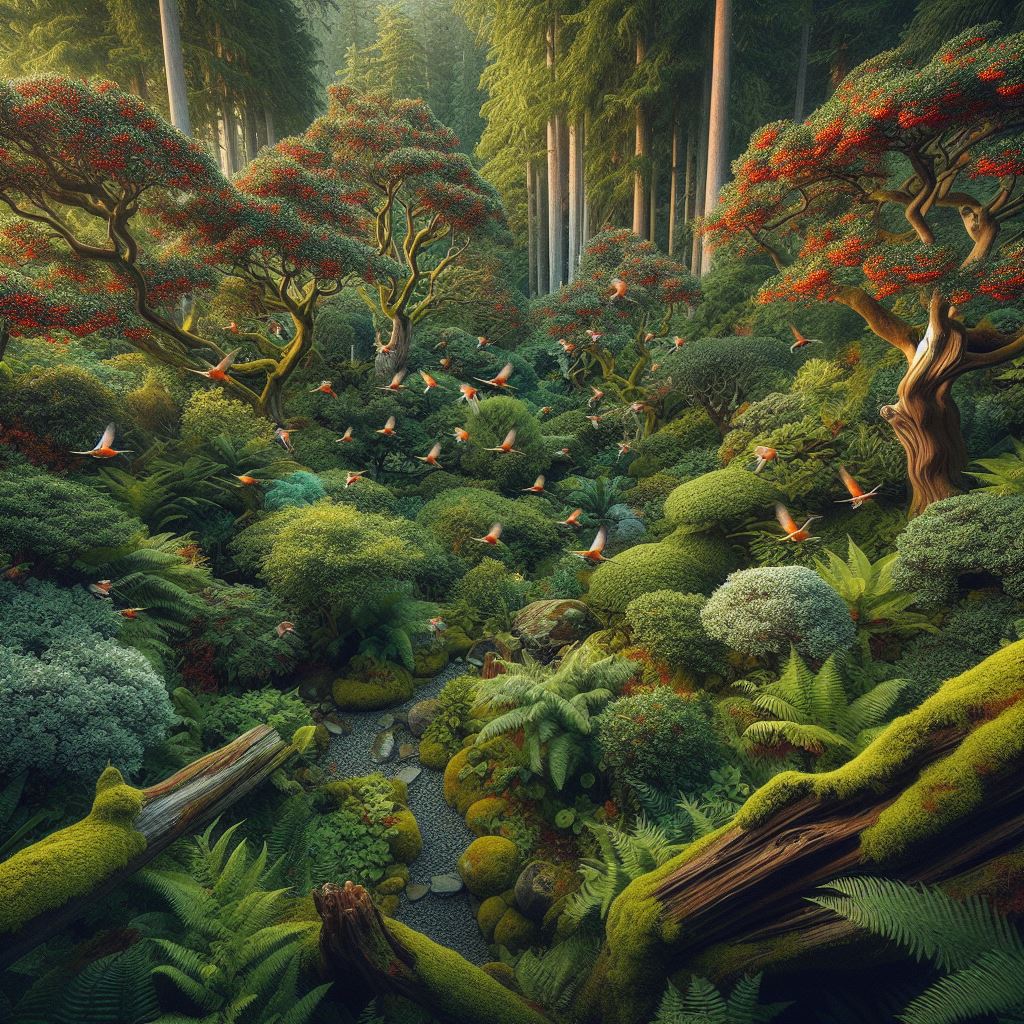
Illustration conveying 'Native Plants for Shelter in the Northwest US'
Birdhouses for Shelter
Another way to provide shelter and nesting sites is by installing birdhouses in your garden, mimicking natural cavities that some birds use to nest, such as holes in trees, rocks, or buildings. Birdhouses can attract various bird species, depending on their design, size, and location. Some examples of birdhouses for North America are:
-
Bluebird house: A small wooden box with a 1.5-inch round entrance hole, which is large enough for bluebirds but small enough to exclude larger birds. Bluebird houses attract eastern, western, and mountain bluebirds, as well as tree swallows and chickadees. They are mounted on a pole or post at least 5 feet above the ground, facing an open field or lawn.
-
Wren house: A small wooden box with a 1.125-inch round entrance hole, which is ideal for wrens and other small birds. Wren houses attract house wrens, Carolina wrens, Bewick’s wrens, chickadees, and nuthatches. They are hung from a branch or wire at least 5 feet above the ground, near a shrub or a tree.
-
Woodpecker house: A large wooden box with a 2.5-inch round entrance hole, which is suitable for woodpeckers and other cavity-nesting birds. Woodpecker houses attract downy, hairy, red-bellied, and red-headed woodpeckers, flickers, and sapsuckers. They are attached to a tree trunk or branch at least 10 feet above the ground, in a wooded area or an orchard.
-
Owl house: A large wooden box with a 3-inch round entrance hole, which is big enough for owls but too small for most predators. Owl houses attract screech, barn, and barred owls, kestrels, and wood ducks. They are mounted on a pole or post at least 15 feet above the ground, near a wooded area or a water source.
Tips for Planting and Installing Shelter
When creating shelter for birds in your garden, consider your space, light conditions, and the preferences of the birds you want to attract. Here are tips for different spaces:
-
Small yards: Plant shrubs or trees in large pots or raised beds. Opt for dwarf or compact varieties that suit limited space and provide protection near windows, walls, or fences.
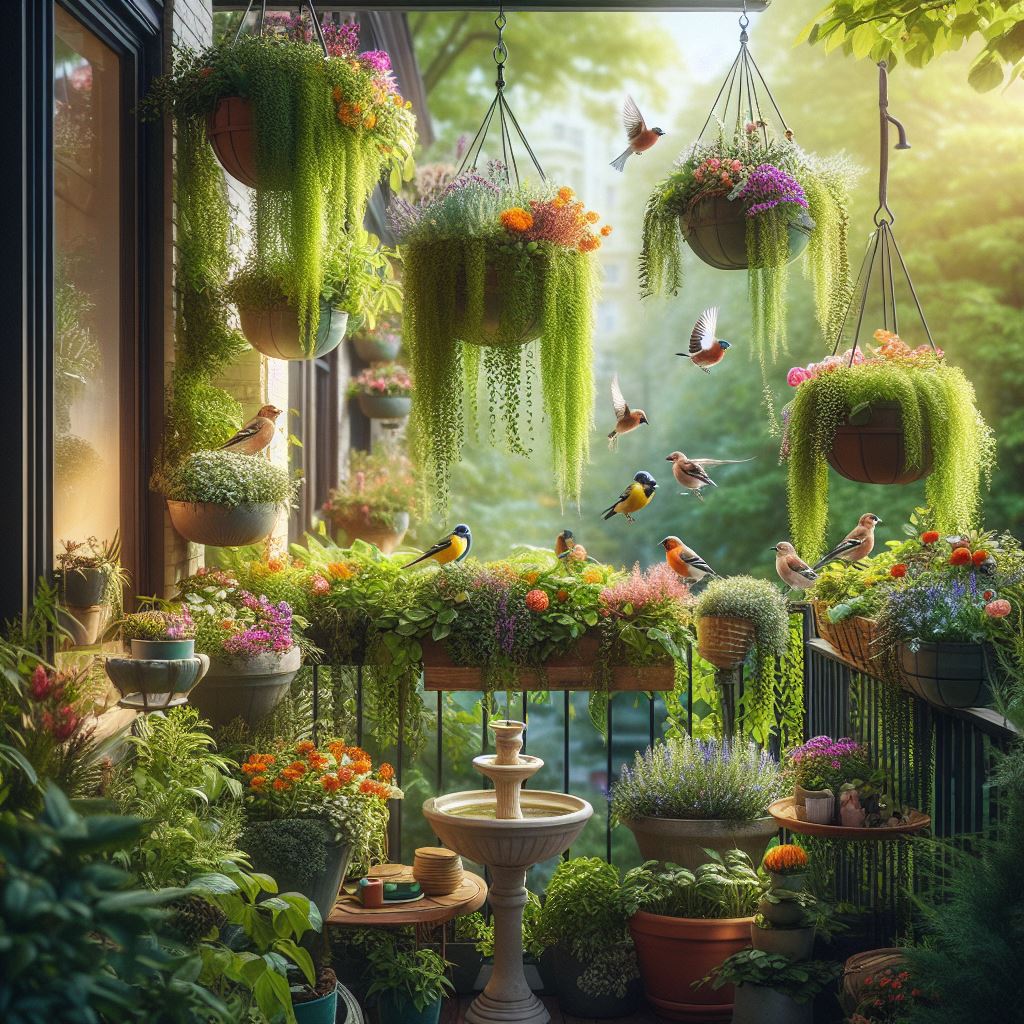
Illustration conveying 'Tips for planting and installing shelter in small yards'
-
Medium yards: Plant bird-friendly shrubs or trees in rows or clusters along the fence or lawn edge, ensuring diverse food sources. Mix evergreen and deciduous varieties, leaving space for birds to move.
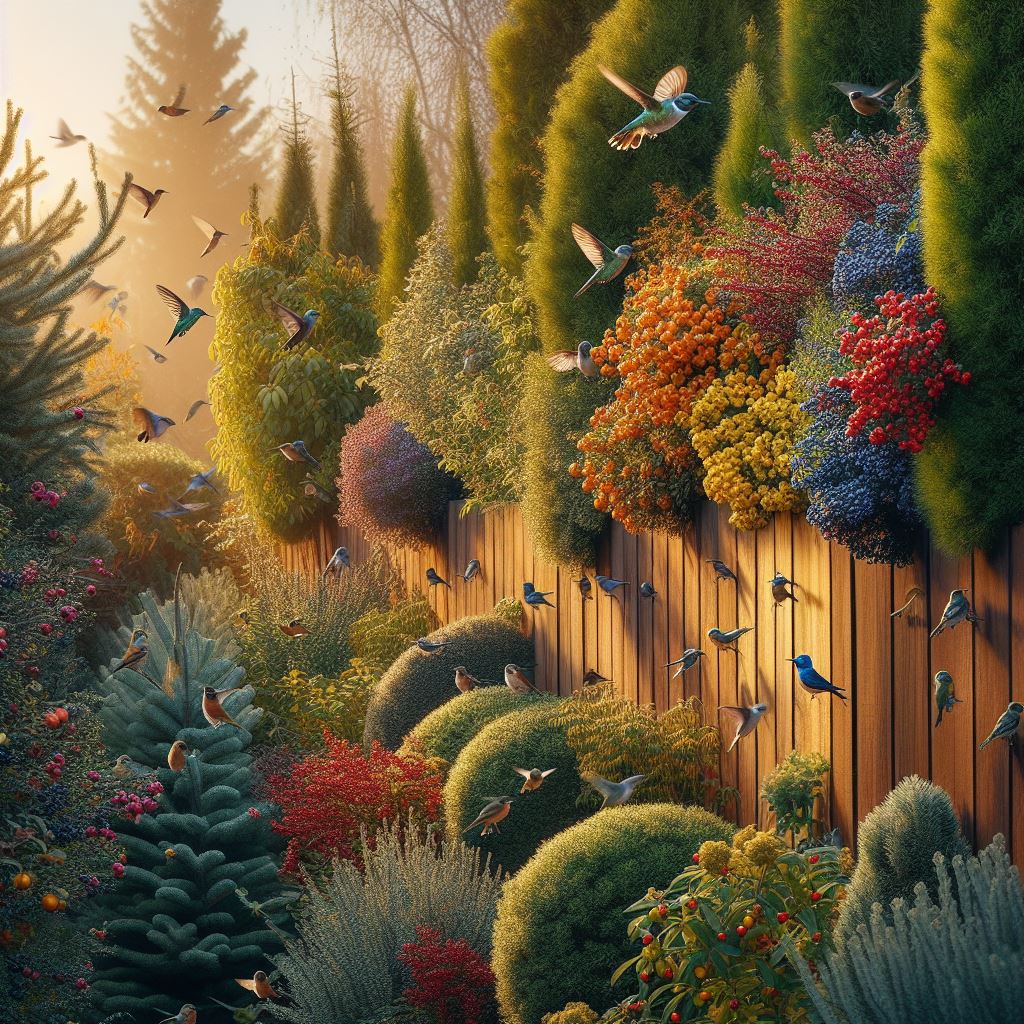
Illustration conveying 'Tips for planting and installing shelter in small yards'
-
Large yards: Plant shrubs or trees at least 6 feet apart, allowing proper growth and air circulation. Select species with different bloom times and colors, adding rocks, logs, or brush piles for more shelter.
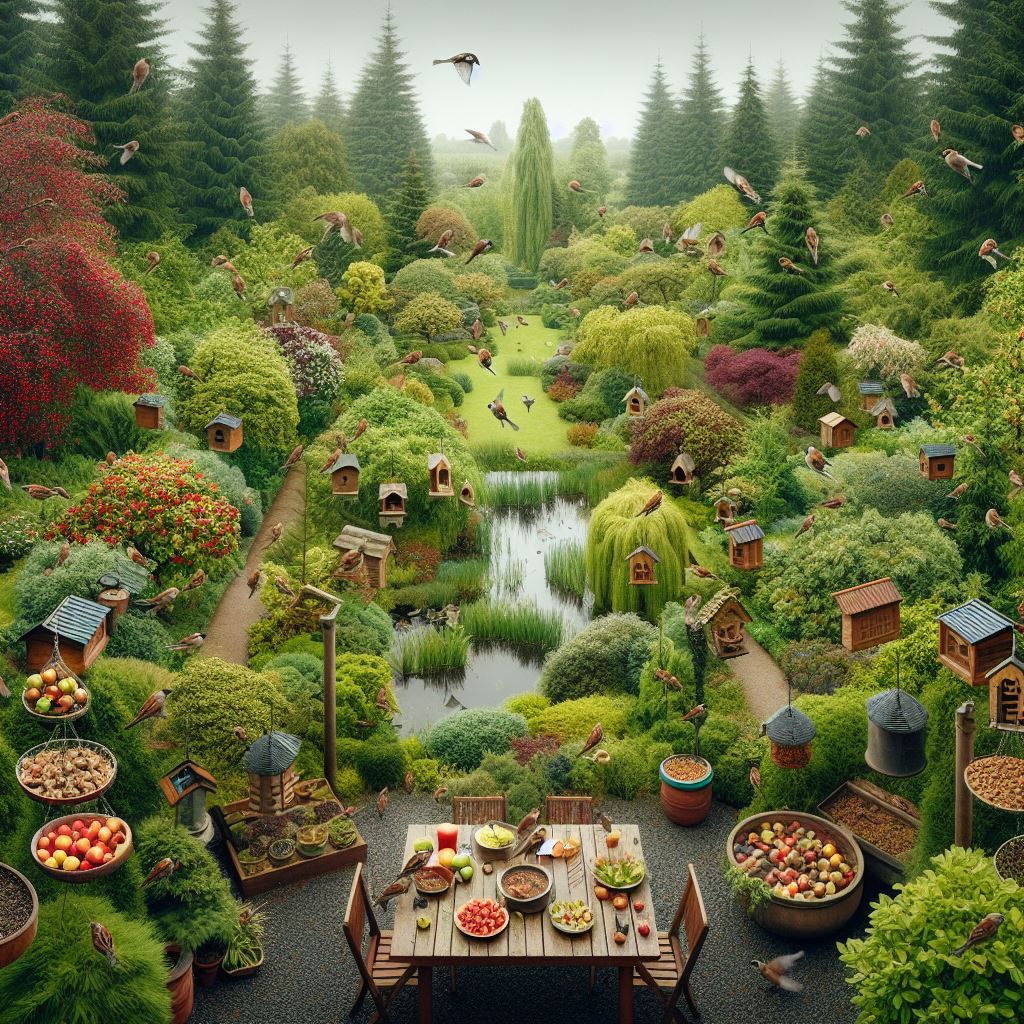
Illustration conveying 'Tips for planting and installing shelter in large yards'
Installing Birdhouses - Tips for Safety and Comfort
When installing birdhouses, follow these guidelines to ensure bird safety and comfort:
-
Choose birdhouse designs tailored to the species you wish to attract, considering entrance hole size, location, height, and depth.
-
Mount birdhouses on sturdy poles or posts at least 5 feet above the ground, avoiding hanging them from branches or wires to prevent swaying.
-
Face birdhouses away from prevailing winds and direct sunlight, preventing overheating and water damage. East or southeast-facing directions are preferable.
-
Regularly monitor birdhouses during the nesting season, checking for occupancy, cleanliness, and the absence of parasites or predators.
Creating a bird-friendly garden with shelter for birds is a rewarding activity. By planting native shrubs and trees and installing birdhouses, you can invite birds to your backyard, fostering a more balanced, disease-free, and productive ecosystem. Plant some native plants, add birdhouses, and enjoy the beauty and benefits of having birds in your garden.
Section 4: Inviting Wings to Rest - Creating Perfect Perches
Crafting a dynamic garden atmosphere with strategic perches for observation and repose.
To infuse vitality into your garden, consider incorporating perches for birds, providing essential spots for rest, observation, and interaction. These perches, whether natural or artificial, serve crucial functions such as energy conservation, temperature regulation, predator avoidance, and communication, while also offering an engaging spectacle for bird enthusiasts.
Natural and Artificial Perches
Perches can be either natural, sourced from the environment like trees, branches, rocks, or ledges, or artificial, crafted by humans, including poles, wires, fences, or platforms. The choice between the two depends on your garden's space and aesthetic preferences. Examples of perches include:
-
Trees: Planting native trees or utilizing existing ones like fruit or ornamental trees provides birds with favored perching spots, offering shade, food, and shelter.
-
Branches: Leaving or pruning branches allows for various shapes and heights. Artificial branches made of bamboo, metal, or plastic can also be employed.
-
Rocks: Whether natural boulders or artificial ones made of concrete, ceramic, or resin, rocks serve as perches for activities such as sunbathing, preening, or drinking.
-
Platforms: Flat surfaces like logs, stumps, or artificial platforms made of metal, plastic, or glass, mounted on poles, posts, walls, or suspended from wires, ropes, or chains, provide additional perching options.
Considerations for Different Birds
When selecting and placing perches, understanding the specific needs and preferences of the birds you aim to attract is vital. Tailor perches to accommodate variations in bird size, shape, and behavior. Consider factors such as perch height, openness, curvature, and texture based on the bird species. Here are some tips different sized birds:
-
Small Birds: For species like hummingbirds, finches, or warblers, opt for thin and flexible perches near nectar sources but strategically positioned to avoid territorial conflicts.
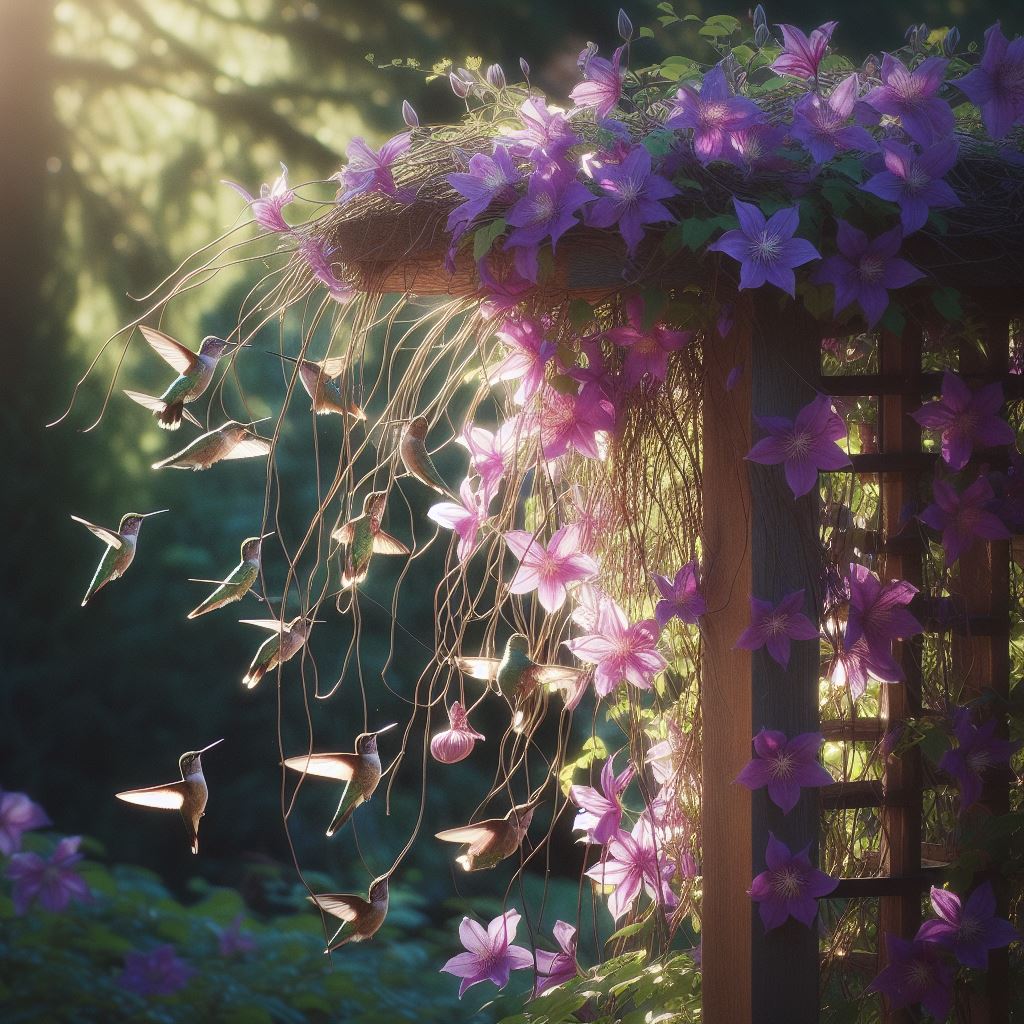
Illustration conveying 'Natural and artificial perches for small birds'
-
Medium Birds: Robins, jays, or woodpeckers favor thick and sturdy perches. Place these near food sources, balancing accessibility without being too distant.
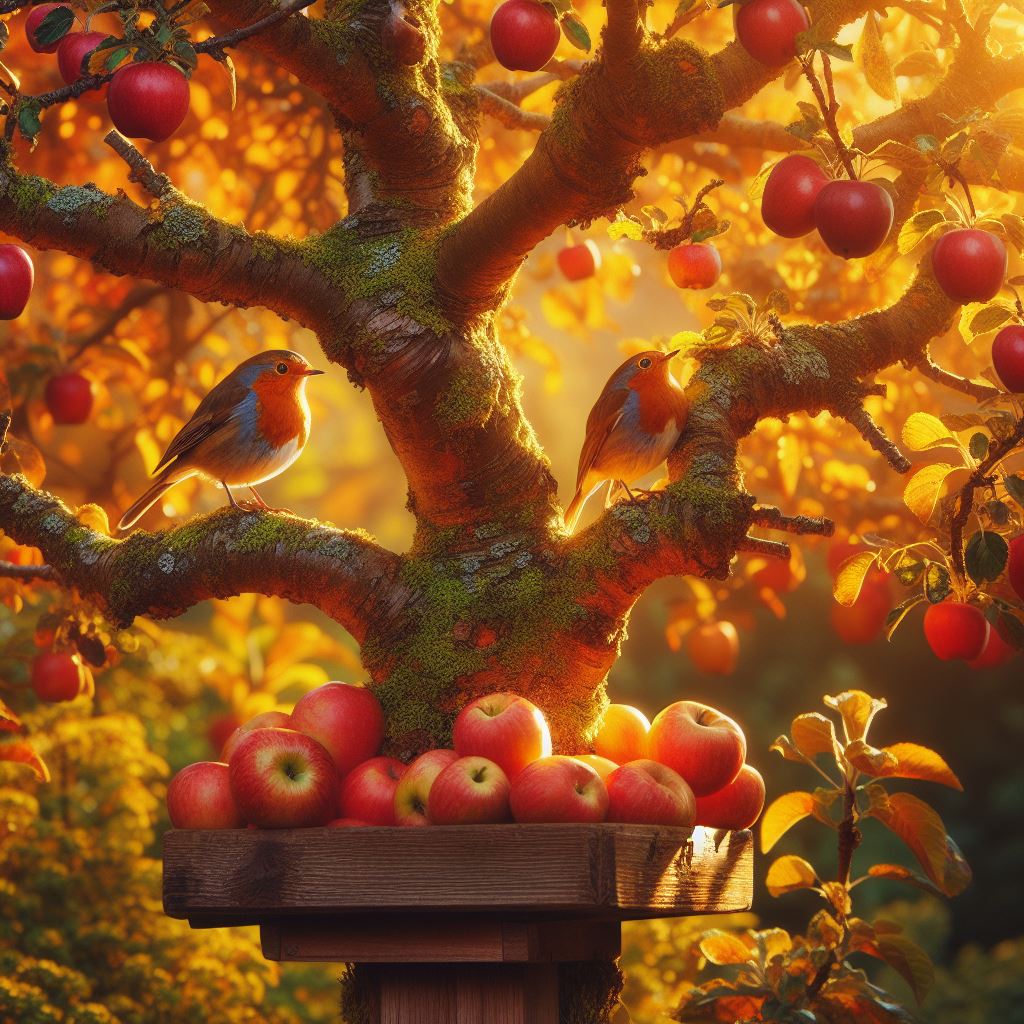
Illustration conveying 'Natural and artificial perches for medium birds'
-
Large Birds: Hawks, owls, or crows prefer strong and stable perches. Situate them close to shelter sources for safety and visibility without compromising height.
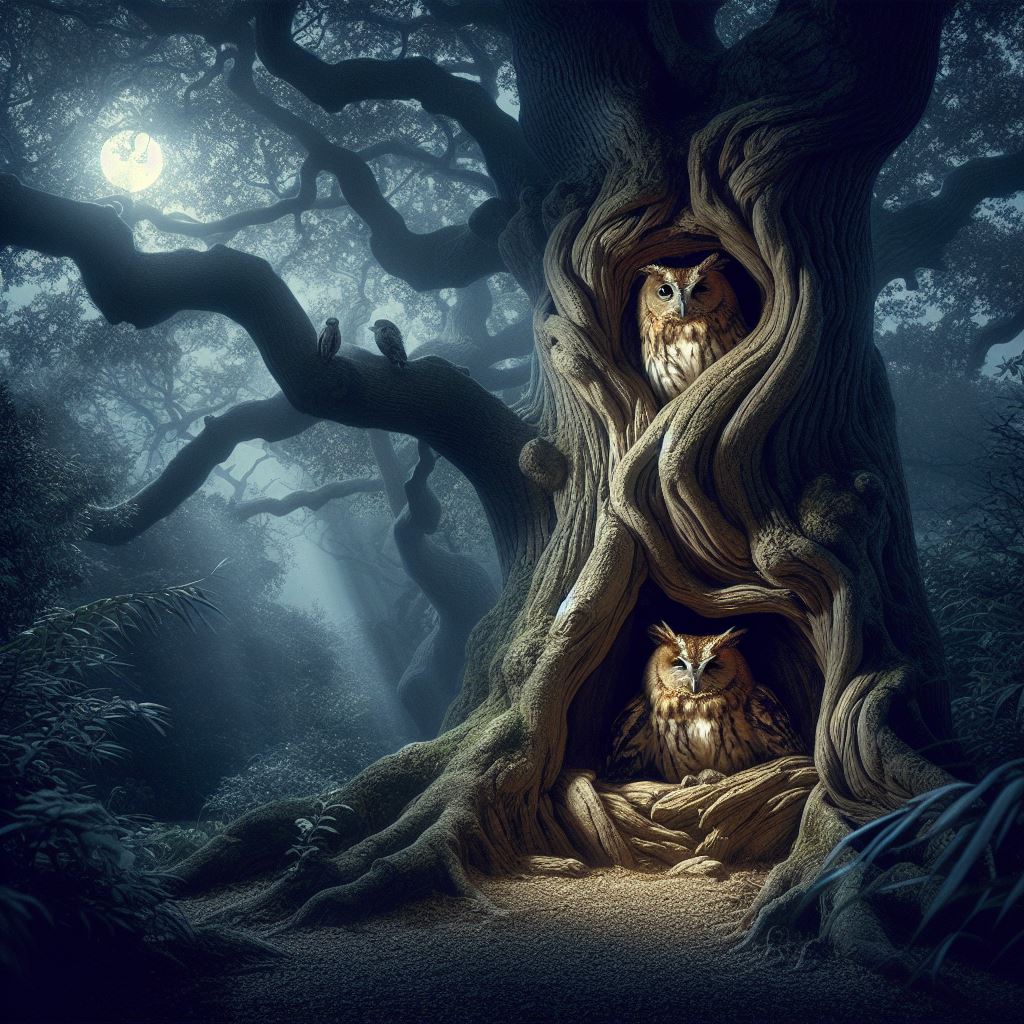
Illustration conveying 'Natural and artificial perches for large birds'
By integrating perches into your garden, you create a vibrant setting for both birds and observers. The birds find a place to rest, preen, and survey, offering insights into their behaviors and personalities. Additionally, perches contribute to the visual allure of your garden, introducing vertical elements and contrasting textures against the floral landscape.
Additional Tips
-
Avoid using pesticides and herbicides, as they can harm birds and their food sources.
-
Minimize noise and disturbance in your garden to create a peaceful haven for birds.
-
Learn about the birds in your area and tailor your garden to their specific needs and preferences.
-
Join a birdwatching group or online community to connect with other bird enthusiasts and learn more about attracting birds to your garden.
Conclusion
Cultivating a bird-friendly garden enriches your space, supporting both visual appeal and biodiversity. Witness your garden evolve into a vibrant haven, embracing nourishment, hydration, shelter, and perching for transformative charm.
Experience the gratification and accessibility of creating a bird-friendly space by following these steps. Explore native plants, join birdwatching groups, and share photos online to inspire fellow enthusiasts.
Creating a bird-friendly garden enhances avian and personal well-being, fostering a deeper connection with nature and preserving wildlife. As Rachel Carson wisely said, "Contemplating earth's beauty provides enduring strength." Seize the chance to craft your bird-friendly garden today!










